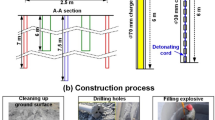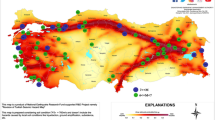Abstract
This study has been conducted to evaluate the effect of the isolation layer on the seismic improvement of concrete gravity dams considering dam–reservoir interaction. Koyna dam in India, due to both horizontal and vertical components of Koyna earthquake, is modeled as a case study to show the effect of the upstream isolation layer on the seismic response of concrete gravity dams, and also the interaction effect is considered in models. The water is taken as a compressible, inviscid fluid and the foundation as rigid. Gravity dams are considered as 2D structures due to long dimension in cross-stream direction and plane strain assumptions. ANSYS software was used for analysis so that the fixed smeared crack model is used to consider the nonlinear behavior of mass concrete. A flexible layer which is attached to the upstream face of the dam under different thickness and material properties is considered. The response of unisolated and isolated dams is compared under various conditions. Finally, the effect of unisolated and isolated layers in the reduction of the seismic response of the concrete is evaluated under various thicknesses comparatively. Considering obtained results revealed that the layer can have the reducing effect on responses and crack propagation process of dam model because of damping the induced hydrodynamic pressure due to the earthquake.

Reproduced with permission from ANSYS (2014)

Reproduced with permission from ANSYS (2014)





Reproduced with permission from Zhang et al. (2013)












Reproduced with permission from Wilcoski et al. (2001)


Similar content being viewed by others
References
ACI (1998) Finite element analysis of fracture in concrete structures: State-of-the-art, 4463R-97. American Concrete Institute, Michigan
Al-Eidi B, Hall JF (1989a) Non-linear earthquake response of concrete gravity dam, part 1: modeling. Earthquake Eng Struct Dynam 18:837–851
Al-Eidi B, Hall JF (1989b) Non-linear earthquake response of concrete gravity dam, part 2: behavior. Earthquake Eng Struct Dynam 18:85–865
Altunisik AC, Sesli H (2015) Dynamic response of concrete gravity dams using different water modelling approaches: Westergaard, Lagrange and Euler. Comput Concr 16(3):429–448
ANSYS (2014) ANSYS version 14 reference manual. ANSYS Inc., Canonsburg, PA
Ardakanian M, Ghaemian M, Mirzabozorg H (2006) Nonlinear behavior of mass concrete in three dimensional problems using damage mechanics approach. Eur Earthq Eng 2:65–89
Battacharjee SS, Leger P (1992) Concrete constitutive model for non-linear seismic analysis of gravity dams state-of-the-art. Can J Civ Eng 19:492–509
Battacharjee SS, Leger P (1994) Application of NLFM models to predict cracking in concrete gravity dams. ASCE Struct Eng 120:1255–1271
Calayir Y, Karaton M (2005) A continuum damage concrete model for earthquake analysis of concrete gravity dam–reservoir systems. Soil Dyn Earthq Eng 25:857–869
Cambridge material selection software—CMS 2.04 (1994)
Chopra AK (1967) Hydrodynamic pressures on dams during earthquakes. Proc ASCE J Eng Mech Div 93(EM6):205–223
Daneshbod Y, Talebbeydokhti N (2006) Dam–reservoir seismic analysis by the Eulerian method, Kowsar dam, a case study. IJST Trans Civ Eng 30(B1):43–53
Faria R, Oliver J, Cevera M (1998) A strain-based plastic viscose damage model for massive concrete structures. Int J Solids Struct 35:1533–1558
Feng LM, Pekauo OA (1996) Cracking analysis of arch dams by 3D boundary element method. J Struct Eng 122(6):691–699
Gellis VK, Kalitseva IS, Mel’nikov EP, Sheinin IS (1992) On-site studies of an experimental air curtain on the dam of the Krivoporozhsk hydroelectric station. Hydrotech Constr 26(10):647–652
Ghaemian M, Ghobarah A (1999) Nonlinear seismic response of concrete gravity dams with dam–reservoir interaction. Eng Struct 21:306–315
Ghrib F, Tinawi R (1995) An application of damage mechanics for seismic analysis of concrete gravity dams. Earthq Eng Struct Dyn 24:157–173
Gunglun W, Pekau OA, Chuhan Z, Shaumin W (2000) Seismic fracture analysis of concrete gravity dams based on nonlinear fracture mechanics. Eng Fract Mech 65:67–87
Hall JF, El-Aidi B (1989) Hydrodynamic isolation of concrete dams. In: Proceedings of the seismic engineering structures congress, San Francisco, pp 307–316
Hall JF, Dowling MJ, El-Aidi B (1991) Defensive earthquake design of concrete gravity dams. Report No. EERL 91-02, California Institute of Technology, Pasadena
Hall JF, Dowling MJ, El-Aidi B (1992) Defensive earthquake design of concrete gravity dams. Dam Eng III(4):249–264
Hanna YG, Humar JL (1983) Closure to boundary element analysis of fluid domain. Proc ASCE J Eng Mech Div 109(EM2):666–667
Hariri-Ardebili MA, Seyed-Kolbadi SM (2015) Seismic cracking and instability of concrete dams: Smeared crack approach. Eng Fail Anal 52:45–60
Hariri-Ardebili MA, Mirzabozorg H, Ghaemian M (2013a) Pulvino and peripheral joint effects on static and seismic safety of concrete arch dams. Sci Iran Trans A Civ Eng 20:1579–1594
Hariri-Ardebili MA, Seyed-Kolbadi SM, Mirzabozorg H (2013b) A smeared crack model for seismic failure analysis of concrete gravity dams considering fracture energy effects. Struct Eng Mech 48:17–39
Hariri-Ardebili MA, Mirzabozorg H, Kianoush MR (2014) Structural safety of high arch dams with variable water levels based on seismic performance evaluation. IJST Trans Civ Eng 38(C1+):175–190
Hatami K (1996) A model for reservoir bottom absorption effects in seismic response analysis of concrete dams. In: 1995 Student paper competition, EERI 48th annual meeting, Los Angeles, CA
Hatami K (1997) Effect of reservoir boundaries on the seismic response of gravity dams. Ph.D. thesis, McMaster University, Hamilton, ON, Canada
Hatami K, Ghobarah A (1995) Reduction of the seismic response of concrete gravity dams using hydrodynamic isolation. In: Proceedings of the seventh Canadian conference on earthquake engineering, Montreal, pp 333–340
Horii H, Chen SC (2003) Computational fracture analysis of concrete gravity dams by crack-embedded elements-toward an engineering evaluation of seismic safety. Eng Fract Mech 70:1029–1045
Lohrasbi AR, Attarnejad R (2008) Crack growth in concrete gravity dams based on discrete crack method. Am J Eng Appl Sci 1(4):318–323
Lombardo VN, Mikhailov LP, Semenov IV (1987) Studies and design of earthquake resistant concrete dams. In: Proceedings of the international symposium on earthquake and dams, vol 1, ICOLD, Beijing, China, pp 223–241
Menetrey P, Willam K (1995) Tri-axial failure criterion for concrete and its generalization. ACI Struct J 92:311–318
Mirzabozorg H, Ghaemian M (2005) Nonlinear behavior of mass concrete in three-dimensional problems using smeared crack approach. Earthquake Eng Struct Dynam 34:247–269
Mirzabozorg H, Ghaemian M, Kianoush MR (2004) Damage mechanics approach in seismic analysis of concrete gravity dams including dam–reservoir interaction. Eur Earthq Eng XVIII(3):17–24
Mirzabozorg H, Khaloo AR, Ghaemian M, Jalalzadeh B (2007) Nonuniform cracking in smeared crack approach for seismic analysis of concrete dams in 3D space. Int J Earthq Eng Eng Seismol 2:48–57
Mirzabozorg H, Lamea M, Sehat HR (2012) Hydrodynamic isolation and 3D seismic response of concrete arch dams. Dam Eng 22(3):227–250
Mirzabozorg H, Varmazyari M, Asil Gharehbaghi S (2016) Seismic evaluation of existing arch dams and massed foundation effects. Soils Found 56:19–32
NRC (1990) Earthquake engineering for concrete dams: design, performance, and research needs. National Research Council, Washington
Oliveira S, Faria R (2006) Numerical simulation of collapse scenarios in reduced scale tests of arch dams. Eng Struct 28:1430–1439
Oliver J, Huespe AG, Pulido MD, Blanco S (2004) Computational modeling of cracking of concrete in strong discontinuity settings. Comput Struct 1(1):61–76
Pekau OA, Yuzhu C (2004) Failure analysis of fractured dams during earthquake by DEM. Eng Struct 26:1483–1502
Pekau OA, Chuhan Z, Lingmin F (1991) Seismic fracture of concrete gravity dams. Earthq Eng Struct Dyn 20:335–354
Savinov OA, Sheinin IS, Kalitseva IS, Sheinina IS (1992) Mathematical modeling and theoretical studies of problems of seismic stability of hydraulic structures with an air curtain. Hydrotech Constr 26(10):631–635
Sayın E, Karaton M, Calayır Y (2016) Nonlinear seismic analyses of historical Topuzlu Dam under different seismic loads. Gradevinar 68(11):919–925
Sheinin IS (1992) An air curtain for protecting hydraulic structures from seismic and blast effects. Hydrotech Constr 26(10):609–615
Tsai CS, Lee GC (1989) Hydrodynamic pressures on gravity dams subjected to ground motion. Proc ASCE J Eng Mech Div 115(3):598–617
Wilcoski J, Robert R, Matheu E, Gambill J, Chowdhury M (2001) Seismic testing of a 1/20 scale model of Koyna Dam, U.S. Army Corps of Engineers, Engineering Research and Development Centre, Washington, Report No. erdc tr-01-17
Zhang S-J, Chen J, Zhang Y-Z, Liu H-W (2011) Research of air-cushion isolation effects on high arch dam reservoir. Acta Mech Sin 27(5):675–686
Zhang Sh, Wang G, Yu X (2013) Seismic cracking analysis of concrete gravity dams with initial cracks using the extended finite element method. Eng Struct 56:528–543
Author information
Authors and Affiliations
Corresponding author
Rights and permissions
About this article
Cite this article
Pirooznia, A. Seismic Improvement of Gravity Dams Using Isolation Layer in Contact Area of Dam–Reservoir in Smeared Crack Approach. Iran J Sci Technol Trans Civ Eng 43, 137–155 (2019). https://doi.org/10.1007/s40996-018-0111-6
Received:
Accepted:
Published:
Issue Date:
DOI: https://doi.org/10.1007/s40996-018-0111-6




